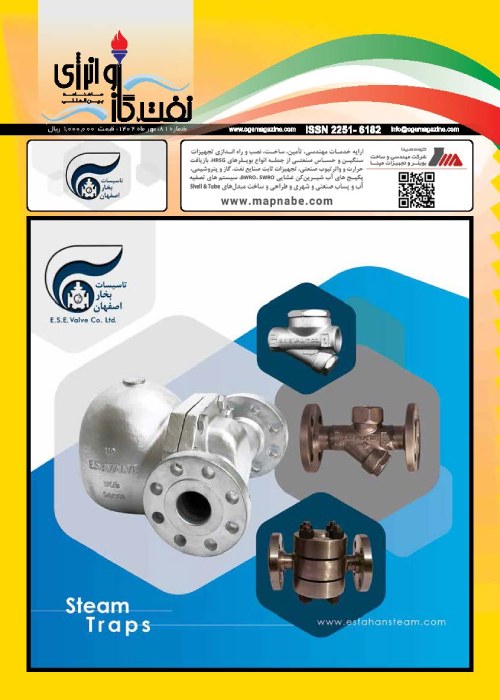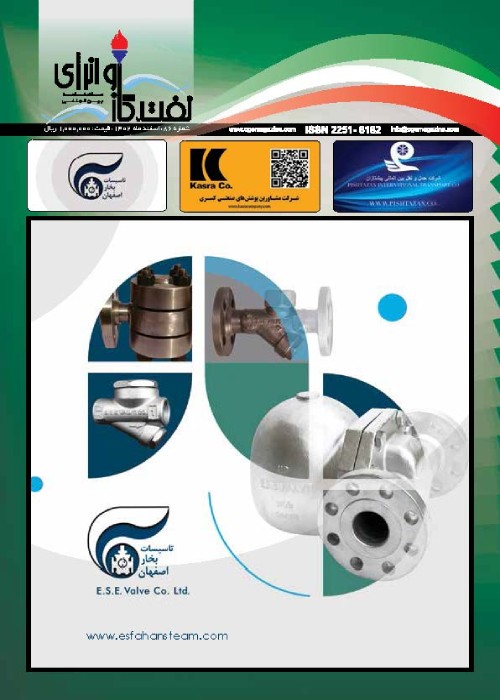فهرست مطالب

ماهنامه نفت، گاز و انرژی
شماره 81 (مهر 1402)
- تاریخ انتشار: 1402/07/25
- تعداد عناوین: 7
- خبر
-
Pages 2-6
In this paper, to s tudy the impact of nanoparticles and to inves tigate various factors such as time, temperature and concentration of nanoparticles in order to change Reservoir rock wettability is discussed. For this purpose, the contact angle of oil droplets near oil rock water as an indicator for the change of reservoir rock wettability was determined at different time and place intervals. By comparing the results, the contact angle can be seen. Water and oil saturated rocks with petroleum wettability after exposure to silicon nanofluids relative to alumina, they mos tly change to hydrophilic wettability. In these experiments, after centering the nanoparticles and modifying their surface using bonding of nanofluids are prepared and carbonate rock is placed in the nanofluid and the wettability of the rock changes by measuring the angle. The contact of oil droplets with rock is inves tigated in its presence. The results showed that these nanoparticles have the ability to change the wettability of carbonate rock from they are oil-friendly to hydrophilic and can be used to increase oil extraction.
Keywords: Nanoparticles, Increase oil production, Wettability, Alumina, silica, contact angle -
Pages 20-25
Nowadays, due to the increasing use of Rotary S teerable Sys tems (RSS) in deviated drilling, it has become necessary to know more precisely the dynamic mechanism of their operation, these sys tems are designed to resis t drilling vibrations as much as possible, however and inevitably. They are subject to long-term exposure to these vibrations. Torsional vibrations, in addition to possible failure, reduce the penetration rate of the rotary guided sys tem, so the ability to predict these vibrations can play a significant role in the accuracy of deviation drilling optimization with these sys tems and reduce non-productive time and drilling cos ts, which machine learning algorithms have a high potential in These types of s tudies. The purpose of this s tudy is to demons trate the high accuracy of artificial neural network (ANN) in predicting the intensity of torsional vibration (s tick/slip) of rotary s teerable sys tems, which by choosing appropriate input and output parameters and optimal design, an artificial neural network with an accuracy of 89.9% and an error of less than 0.05 was yielded.
Keywords: RSS, Torsional Vibrations, S tick, Slip, Deviated Drilling, Artificial Neural Networks -
Pages 1-7
Waterflooding as a secondary EOR and Smart waterflooding as a tertiary chemical EOR method has long his tory which mainly have been applied in sands tone reservoirs. On the contrary, in Iran there are a few oil fields that water injection has been experienced. However, the need for chemical EOR implementation and lack of gas source availability pushes Iranian authorities to go for waterflooding in the WK area. The main challenges of the nominated oil fields in the wes t Karoon area is that they mainly producing from carbonate rocks with different fluid characteris tics specially their API gravity that is limited to the heavy crude oils and the size of the project in terms of area and economy. Immense s tudies are needed in order to evaluate the possibility of approach success. Reference to the favored projects implemented in the world, by tuning injection water in terms of salts and other rheology properties by adding surfactant and/or polymers; the rock wettability alteration, interfacial tension reduction and better mobility control to help increasing sweep efficiency are variables that would increase recovery factor under smart waterflooding which can encourage using that approach.
Keywords: Chemical EOR, Smart Waterflooding, Wettability alteration, Carbonate Rock, Wes t Karoon


